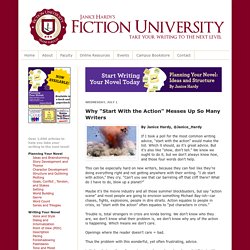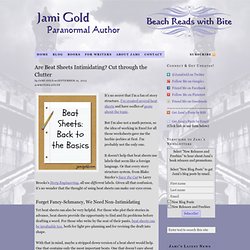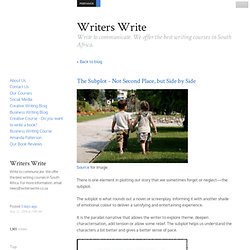

Why "Start With the Action" Messes Up So Many Writers. By Janice Hardy, @Janice_Hardy If I took a poll for the most common writing advice, “start with the action” would make the list.

Which it should, as it’s great advice. But it’s also like “show, don’t tell.” We know we ought to do it, but we don’t always know how, and those four words don’t help. This can be especially hard on new writers, because they can feel like they’re doing everything right and not getting anywhere with their writing. Maybe it’s the movie industry and all those summer blockbusters, but say “action scene” and most people are going to envision something Michael Bay-ish—car chases, fights, explosions, people in dire straits.
Openings where the reader doesn’t care = bad. Thus the problem with this wonderful, yet often frustrating, advice. Let’s break down these four not-so-simple words and explore what “start with the action” really means. Simple version: Start with something happening—characters physically doing something to achieve a goal. Sounds crazy simple, right? A Handwritten Plot Outline J.K. Rowling Made While Writing ‘Harry Potter and the Order of the Phoenix’ Move Along: Fixing Pacing Problems. By Janice Hardy, @Janice_Hardy Pacing problems fall into two categories: too slow or too fast.

While this makes it easy to diagnose the trouble, it takes a bit more to solve the actual problem. Too slow can be an editing issue, a stakes issue, or even a structure issue. Too fast can be a plotting problem, a characterization problem, or yes, a structure problem. If your pacing isn’t where you want it to be, try to identify what the problem is. Too Slow While any number of things can contribute to a slow pace, too much of something is usually the culprit. Description: Look for long descriptive passages, especially if the scene is supposed to be fast-paced or have a lot of action. Basic-Beat-Sheet. Are Beat Sheets Intimidating? Cut through the Clutter. It’s no secret that I’m a fan of story structure.

I’ve created several beat sheets and have oodles of posts about the topic. But I’m also not a math person, so the idea of working in Excel for all those worksheets gave me the heebie-jeebies at first. I’m probably not the only one. It doesn’t help that beat sheets use labels that seem like a foreign language. Or that every story structure system, from Blake Snyder’s Save the Cat to Larry Brooks’s Story Engineering, all use different labels.
Forget Fancy-Schmancy, We Need Non-Intimidating Yet beat sheets can also be very helpful. With that in mind, maybe a stripped down version of a beat sheet would help. Beats Are Not Created Equal Considering all those different labels from the different story structure systems, it seems like there’s no way we could make them play nicely together. Well, beats are simply plot events that change the course of a story. Elements of Suspense in Writing: 6 Secret to Creating and Sustaining Suspense. Thriller writing?

Mystery writing? Literary fiction? It’s all the same: Building apprehension in the minds of your readers is one of the most effective keys to engaging them early in your novel and keeping them flipping pages late into the night. Simply put, if you don’t hook your readers, they won’t get into the story. The Subplot - Not Second Place, but Side by Side. There is one element in plotting our story that we sometimes forget or neglect—the subplot.

The subplot is what rounds out a novel or screenplay, informing it with another shade of emotional colour to deliver a satisfying and entertaining experience. It is the parallel narrative that allows the writer to explore theme, deepen characterisation, add tension or allow some relief. The subplot helps us understand the characters a bit better and gives a better sense of pace. Love and other pursuits. In a thriller, the love story is often the subplot. Plot Devices Gen. Main/Plot Hole. The Thirty-Six Dramatic Situations. The Thirty-Six Dramatic Situations is a descriptive list which was created by Georges Polti to categorize every dramatic situation that might occur in a story or performance.

To do this Polti analyzed classical Greek texts, plus classical and contemporaneous French works. He also analyzed a handful of non-French authors. In his introduction, Polti claims to be continuing the work of Carlo Gozzi, who also identified 36 situations. Publication history[edit] “Gozzi maintained that there can be but thirty-six tragic situations. This list was published in a book of the same name, which contains extended explanations and examples. The list is popularized as an aid for writers, but it is also used by dramatists, storytellers and many others. The 36 situations[edit] Each situation is stated, then followed by the necessary elements for each situation and a brief description.
See also[edit] References[edit] External links[edit] Why is it so hard to write a decent ending? What Do You Do When Your Novel Goes Off Course? How to Write Descriptive Passages Without Boring the Reader or Yourself. How to Write Descriptive Passages Without Boring the Reader or Yourself. You're about 25 percent of the way through your novel. Time for an Act One Break? How to write yourself out of a dead end. The 5 laws of making a story complicated without creating an ungodly mess. 20 Great Infodumps From Science Fiction Novels. How Do You Bridge The Gap Between Two Cool Moments In Your Novel? Make Your Epic Space Novel Live Up To Your "Elevator Pitch" What's The Difference Between Story And Plot? The Secrets of Ending a Story Well.